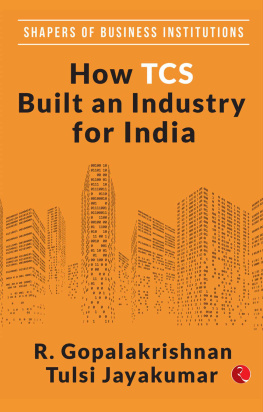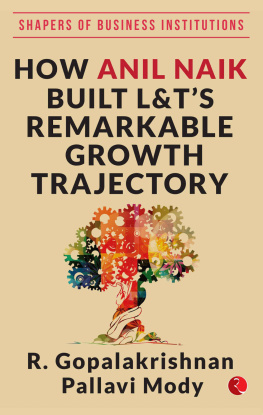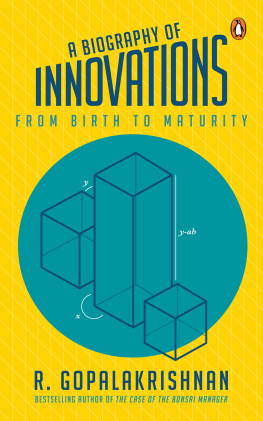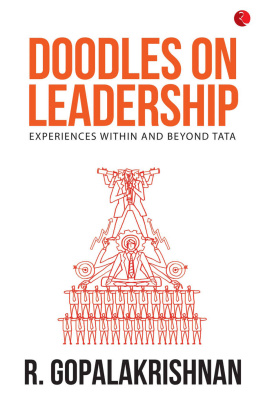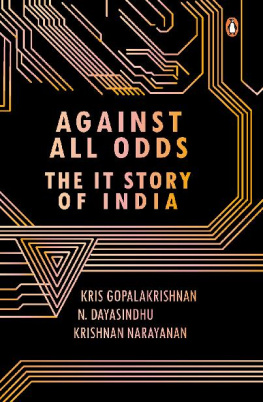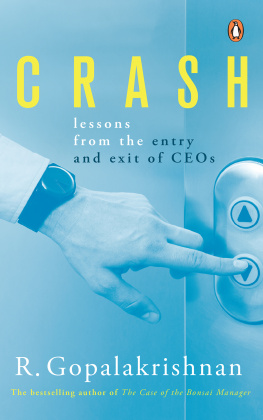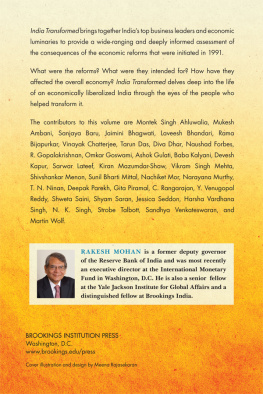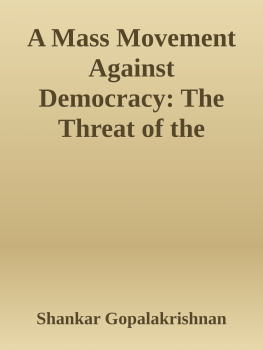R. Gopalakrishnan - HOW TCS BUILT AN INDUSTRY FOR INDIA
Here you can read online R. Gopalakrishnan - HOW TCS BUILT AN INDUSTRY FOR INDIA full text of the book (entire story) in english for free. Download pdf and epub, get meaning, cover and reviews about this ebook. year: 2019, publisher: Rupa Publications, genre: Politics. Description of the work, (preface) as well as reviews are available. Best literature library LitArk.com created for fans of good reading and offers a wide selection of genres:
Romance novel
Science fiction
Adventure
Detective
Science
History
Home and family
Prose
Art
Politics
Computer
Non-fiction
Religion
Business
Children
Humor
Choose a favorite category and find really read worthwhile books. Enjoy immersion in the world of imagination, feel the emotions of the characters or learn something new for yourself, make an fascinating discovery.
- Book:HOW TCS BUILT AN INDUSTRY FOR INDIA
- Author:
- Publisher:Rupa Publications
- Genre:
- Year:2019
- Rating:5 / 5
- Favourites:Add to favourites
- Your mark:
- 100
- 1
- 2
- 3
- 4
- 5
HOW TCS BUILT AN INDUSTRY FOR INDIA: summary, description and annotation
We offer to read an annotation, description, summary or preface (depends on what the author of the book "HOW TCS BUILT AN INDUSTRY FOR INDIA" wrote himself). If you haven't found the necessary information about the book — write in the comments, we will try to find it.
HOW TCS BUILT AN INDUSTRY FOR INDIA — read online for free the complete book (whole text) full work
Below is the text of the book, divided by pages. System saving the place of the last page read, allows you to conveniently read the book "HOW TCS BUILT AN INDUSTRY FOR INDIA" online for free, without having to search again every time where you left off. Put a bookmark, and you can go to the page where you finished reading at any time.
Font size:
Interval:
Bookmark:
How TCS
Built an Industry
for India

Published by
Rupa Publications India Pvt. Ltd 2020
7/16, Ansari Road, Daryaganj
New Delhi 110002
Copyright R. Gopalakrishnan & Tulsi Jayakumar 2020
The views and opinions expressed in this book are the authors own and the facts are as reported by them which have been verified to the extent possible, and the publishers are not in any way liable for the same.
All rights reserved.
No part of this publication may be reproduced, transmitted, or stored in a retrieval system, in any form or by any means, electronic, mechanical, photocopying, recording or otherwise, without the prior permission of the publisher.
ISBN: 978-93-5333-854-1
First impression 2020
10 9 8 7 6 5 4 3 2 1
The moral right of the authors have been asserted.
This book is sold subject to the condition that it shall not, by way of trade or otherwise, be lent, resold, hired out, or otherwise circulated, without the publishers prior consent, in any form of binding or cover other than that in which it is published.
Contents
Preface
This book, How TCS Built an Industry for India, is the first volume in the Shapers of Business Institutions series that probes the mindsets, behaviour and actions of Shapers of institutions. This book, just as the others in the series, is neither academic nor an anecdotal new mantra book. Management, we believe, is a performance art and not quite a science, and practitioners rarely write about their experiences. Only talented academics and top-class consultants dominate management writing. This series, then, positioned at the intersection of practice and theory, is based on the powerful idea of Experience before Theory.
Indeed, this book, like others in this series, has been co-authored by an accomplished management practitioner and a serious academic, a combination that is a distinctive feature of these volumes. We have used our experience, in the form of our real-life observations on long-lasting and values-based companies, to posit certain hypotheses. We then ask: Can such hypotheses form the basis of a conceptual business model, which can be validated through field interviews? Such an intersection of practice and theory is what sets this series apart from other books on organizations/business leaders, which may have a preponderance of either practice or theory.
The theme of this series is the shaping of good companies into business institutions. Were we to use imagery to distinguish between institutions and companies, the former would be solid, long-lasting and structurally strong, metaphorically like Delhis Red Fort; the latter, on the other hand, would resemble a modern, convenient and practical bungalow. However, bungalows may just survive, they may crumble, or they may evolve into forward-looking institutions, enduring over time and proving to be role models for others interested in converting their own bungalows into institutions. Whether the bungalow simply survives or becomes an institution depends on many factors, which will be explored in these books.
India, in 2019, has more than 5,000 listed companies, as per Bombay Stock Exchange (BSE) data. How many of these companies can evolve into institutions? What does it take for such a mutation? Does it even matter if more companies are shaped into becoming institutions? The authors believe that yes, it does matter, and quite a lot. They believe that the growth of the economy and jobs in India crucially depends on India Inc. producing more and more business institutions, not just more good companies.
ICONIC GEN-L INSTITUTIONS
Around mid-2018, a group of academics from Bhavans SP Jain Institute of Management and Research (SPJIMR) debated ideas around this theme. There are centurion companies and corporate groups, which we refer to as Gen-C companies, which bear all the hallmarks of institutions. These Gen-C institutions bear storied brand names like Tata, Godrej, Birla, Bajaj and TVSall founded about a hundred years ago and thriving to this day.
The current interest, however, lies in the search for Gen-L institutions, with L standing for liberalization. The idea is to identify those institutions that were born or shot into exemplary growth around the time of Indias liberalization in 1991, or in the last half-century. Each of these companies should have a public image that is generally free of controversy, and should have been around long enough for the researchers to make a reasoned judgment. The founder or the leadership team should have shaped the group or company into a sustainable, values-based and high-performing institution. Another criterion important to the authors was that the Shaper be alive and speak on the subject personally. The books in the series are not commentaries on the Shapers; they are intended to be more about the institutions and the institutionalization of mindsets, behaviours and actions.
It is important to mention that the SPJIMR team did not intend to make judgements and comparisons as awards juries do. The team was merely trying to identify some institutions that met certain broad criteria and provided a basis for research as exemplarsthere would surely be more exemplars, yet unidentified.
The process we followed was to identify potential Gen-L institutions, get a consensus on the list from the relevant faculty group, and then write to the Shapers, inviting their respective group or companys participation. One company declined, but six agreed to participateafter subjecting the author group to fair scrutiny.
Scouring through academic literature, the team jointly summarized papers on institution-building and formulated the SPJIMR Mindset-Behaviour-Action (MBA) Gridthe research model that appears at the conclusion of each narrative along with the research methodology and process. This was followed by desk research on the company and field interviews.
The book is arranged into a sequence of chapters that, hopefully, make it both instructive and inspirational, describing the genesis and nature of the industry in which the company operates, the background of the Shaper, the evolution of the company and its people, the MBA instituted by the Shaper, the impact of their transformative leadership, and important experiences, outcomes and lessonsbesides key reader takeaways on the ways of the company and the Shaper. This series is a joint project by two well-established Indian institutionsBhavans SPJIMR and Rupa Publications, Indias oldest book publisher and distributor. The authors and publisher hope that the reader derives both inspiration and learning from the lessons showcased by the six institutions that are the subjects for this series.
This book is about Tata Consultancy Services (TCS) Ltd., Indias multinational information technology (IT) service and consulting company. Its founding leader, F.C. Kohli, will be 96 years of age by the time this book is published, and the authors were privileged to be able to interview him on his early days in this institution. In an orderly fashion, he was succeeded by S. Ramadorai, during whose tenure the company scaled in an unimaginably efficient manner. There were two more CEO successions after Ramadorai. TCS is known for having invented the offshore delivery model for software, which served as an iconic exemplar to many IT services companies that followed. It is no wonder that both Kohli and Ramadorai are regarded as the true bricklayers and Shapers of TCS, and indeed the Indian software industry.
What did they do and under what circumstances? What are the lessons an aspiring Shaper could learn? The book concludes with the TCS Way, which summarizes these actions and inspirations.
Next pageFont size:
Interval:
Bookmark:
Similar books «HOW TCS BUILT AN INDUSTRY FOR INDIA»
Look at similar books to HOW TCS BUILT AN INDUSTRY FOR INDIA. We have selected literature similar in name and meaning in the hope of providing readers with more options to find new, interesting, not yet read works.
Discussion, reviews of the book HOW TCS BUILT AN INDUSTRY FOR INDIA and just readers' own opinions. Leave your comments, write what you think about the work, its meaning or the main characters. Specify what exactly you liked and what you didn't like, and why you think so.

